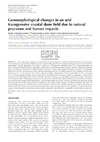Please use this identifier to cite or link to this item:
https://accedacris.ulpgc.es/jspui/handle/10553/41534
| Título: | Geomorphological changes in an arid transgressive coastal dune field due to natural processes and human impacts | Autores/as: | Hernández-Cordero, Antonio I. Hernández-Calvento, Luis Hesp, Patrick A. Perez-Chacon Espino, María Emma |
Clasificación UNESCO: | 250501 Biogeografía 2511 Ciencias del suelo (Edafología) |
Palabras clave: | Aeolian sedimentary landforms Geomorphological and environmental changes Geoindicator Spatio-temporal dynamics Urban tourist |
Fecha de publicación: | 2018 | Proyectos: | Modelización de Los Procesos Naturales y Análisis de Las Consecuencias Ambientales Inducidas Por El Turismo en la Reserva Natural Especial de Las Dunas de Maspalomas (Gran Canaria, Islas Canarias). Consecuencias Ambientales Inducidas Por El Desarrollo Turistico en Espacios Insulares: Alteraciones de Los Procesos Naturales en Sistemas de Dunas Litorales de Canarias y Cabo Verde. Diagnóstico Ambiental de Los Sistemas de Dunas de Canaris Para la Elaboración de Modelos Sostenibles Caracterización de Procesos Socio-Ecológicos de Los Sistemas Playa-Dunas de Canarias Como Base Para Su Gestión Sostenible Análisis de Procesos Naturales y Humanos Asociados A Los Sistemas Playa-Duna de Canarias |
Publicación seriada: | Earth Surface Processes and Landforms | Resumen: | Geomorphological changes in recent decades in an arid transgressive coastal dune system (Maspalomas, Gran Canaria, Canary Islands) are analyzed. The methodology used is based on the generation of two geomorphological maps (1961 and 2003) by interpretation of digital orthophotos. The overlay of both maps in a geographic information system (GIS) enabled the spatial and surface changes of the landforms to be determined, and the processes that generated these changes. Twelve cultural and geomorphological processes were identified from highest to lowest importance, namely: anthropization by urban occupation (114ha changed), stabilization (92.5ha), barchanization (37ha), salinization/halophytication (15ha), anthropization (12.4ha), deflation (11.8ha), dune loss/beach gain (11.3ha), dune formation (9.6ha), progradation (8ha), retrogradation (7.7ha), destabilization (2.7ha) and flooding (0.7ha). Geomorphological changes are associated with a combination of five main factors, three of anthropogenic origin and two natural ones. The natural factors are: (1) the arid climate, which favors changes occurring at high speed; (2) the existence of a progressive sedimentary deficit. Anthropogenic factors are: (3) construction of tourist urbanizations, infrastructures and facilities; (4) installation of equipment or infrastructure on the beaches; (5) the activities carried out by users. These human factors have altered the aeolian dynamics and reduced the area occupied by vegetation in some areas, causing changes in aeolian sedimentary processes. The geomorphological processes identified can be used as indicators of environmental change, allowing us to synthesize the changes in landforms detected, and group all combinations derived from the analysis by GIS and analyze them spatially. Thus, the environmental changes in the transgressive coastal dune systems could be interpreted more effectively. | URI: | https://accedacris.ulpgc.es/handle/10553/41534 | ISSN: | 1096-9837 | DOI: | 10.1002/esp.4382 | Fuente: | Earth Surface Processes and Landforms[ISSN 1096-9837],v. 43, p. 2167-2180 |
| Colección: | Artículos |
Citas SCOPUSTM
31
actualizado el 08-jun-2025
Citas de WEB OF SCIENCETM
Citations
29
actualizado el 08-jun-2025
Visitas
65
actualizado el 27-ene-2024
Descargas
841
actualizado el 27-ene-2024
Google ScholarTM
Verifica
Altmetric
Comparte
Exporta metadatos
Los elementos en ULPGC accedaCRIS están protegidos por derechos de autor con todos los derechos reservados, a menos que se indique lo contrario.
